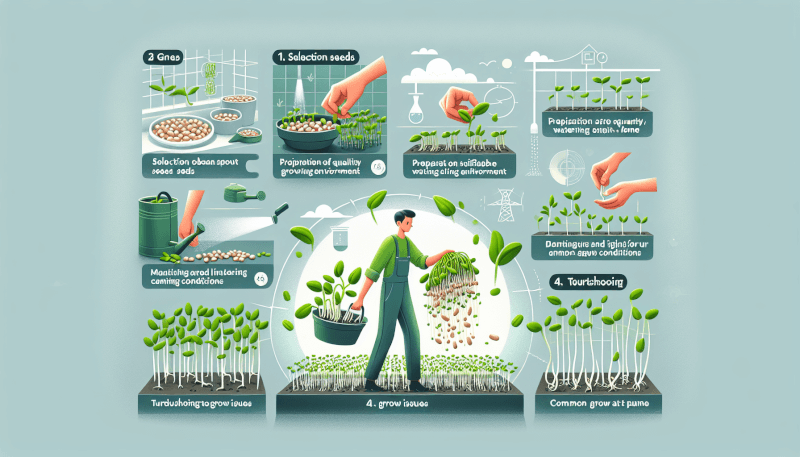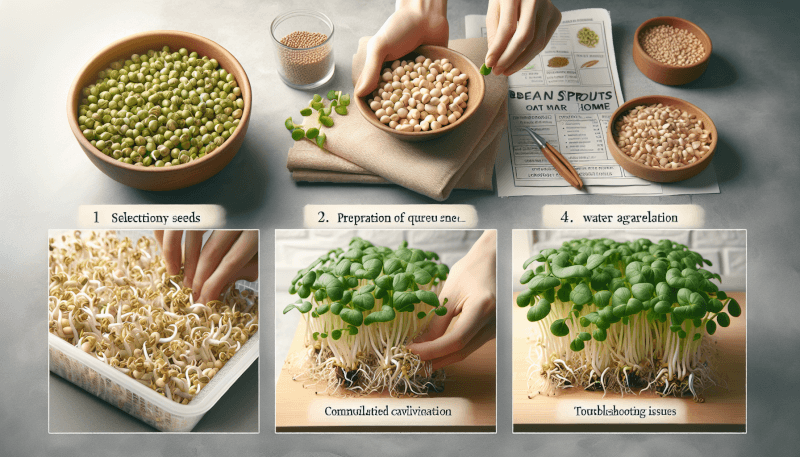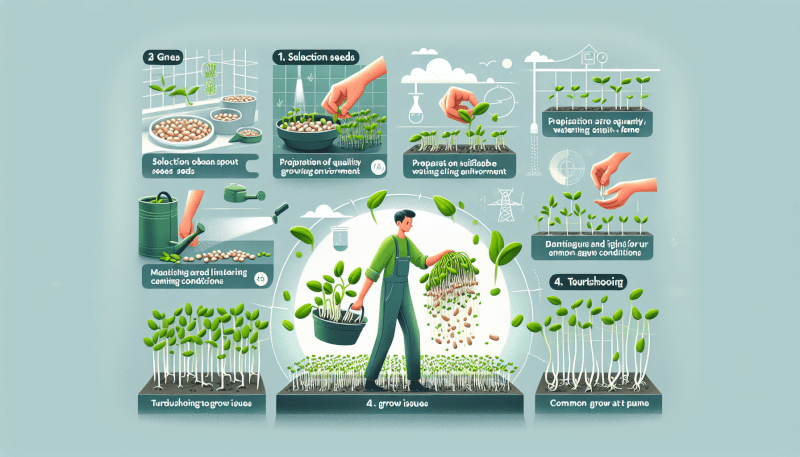Have you ever wanted to grow your own bean sprouts at home? Look no further! In this article, you will find the ultimate guide to successfully growing bean sprout seeds right in the comfort of your own kitchen. From selecting the right seeds to providing optimum growing conditions, we will walk you through each step of the process, ensuring you can enjoy fresh and delicious bean sprouts whenever you please. So roll up your sleeves, grab your gardening gloves, and get ready to embark on a rewarding and tasty journey of growing your own bean sprouts!
Choosing the Right Bean Sprout Seeds

Understanding Different Types of Bean Sprout Seeds
When it comes to choosing the right bean sprout seeds, it’s important to understand that there are different types available. The most common types of bean sprouts are mung bean sprouts and soybean sprouts. Mung bean sprouts are typically thinner and have a slightly sweet flavor, while soybean sprouts are thicker and have a more nutty taste. Depending on your personal preference and the dishes you plan to make, you can choose the variety that suits your taste buds best.
Considering Growing Conditions
Before deciding on bean sprout seeds, it’s crucial to consider the growing conditions in your home. Bean sprouts thrive in warm and moist environments, so make sure you have a suitable location to grow them. They also require a good amount of light to photosynthesize properly, so access to natural or artificial light is essential. Additionally, think about the space you have available and whether you can dedicate it to sprouting bean sprouts. Taking these factors into consideration will help you choose the right bean sprout seeds that will flourish in your specific growing conditions.
Evaluating Seed Quality
When selecting bean sprouts seeds, it’s vital to evaluate the seed quality. Look for seeds that are plump, firm, and undamaged. Avoid seeds that appear shriveled, discolored, or have a musty odor, as these can be signs of poor quality or even mold. It’s also beneficial to choose seeds from reputable sources to ensure they are non-GMO and organic. By carefully evaluating seed quality, you set yourself up for successful sprouting and healthy bean sprouts.
Obtaining Bean Sprout Seeds
Now that you have a good understanding of the different types of bean sprout seeds, growing conditions, and seed quality, it’s time to obtain the seeds. You can find bean sprout seeds at various places such as garden centers, online stores, or even from fellow sprouters. Make sure to read reviews, compare prices, and check for any additional information provided by the seller. By obtaining bean sprout seeds from a reliable source, you can be confident in the quality and success of your sprouting journey.
Equipment and Materials Needed
To grow bean sprouts successfully at home, it’s essential to have the right equipment and materials. Here’s a list of what you’ll need:
Sprouting Container
A sprouting container is necessary to hold the sprouting tray and facilitate proper drainage. It should be food-safe and able to withstand moisture without warping or leaking. There are various types of sprouting containers available, including plastic, glass, or ceramic options. Choose one that suits your preferences and meets your sprouting needs.
Sprouting Tray
A sprouting tray will be the main vessel where your bean sprouts will grow. It should have small holes or a mesh bottom to allow excess water to drain out while retaining the sprouts. The size of the tray depends on the amount of sprouts you plan to produce. Consider the available space and your sprouting goals when selecting a sprouting tray.
Sprouting Lid
A sprouting lid helps create a controlled environment for your sprouts by allowing air circulation while preventing dust, insects, or other contaminants from entering. Look for a lid specifically designed for sprouting trays, ensuring proper fit and functionality.
Water Sprayer
A water sprayer is a convenient tool for rinsing your sprouts without disturbing their delicate growth. Choose a sprayer with a gentle mist setting to prevent any damage to the sprouts.
Seed Rinse Basket
A seed rinse basket is useful for soaking and rinsing your bean sprout seeds thoroughly. It allows you to easily drain excess water without any loss of seeds.
Water Source
A clean and reliable water source is essential for sprouting your bean sprout seeds. Use filtered water or tap water that has been left out for a minimum of 24 hours to allow any chlorine to evaporate. Avoid using hard water or water that may contain contaminants that could affect the sprouts’ quality.
Light Source
Bean sprouts require adequate light for healthy growth. If you have access to natural light, position your sprouting tray near a window or use a grow light if natural light is limited. Ensure the sprouts receive 12-16 hours of light daily for optimal growth.
Preparing the Sprouting Container
Cleaning and Sterilizing the Container
Before using the sprouting container, it’s crucial to clean and sterilize it to eliminate any potential bacteria or mold. Start by washing the container with warm, soapy water, making sure to remove any residue or dirt. Rinse the container thoroughly to remove all soap, then sterilize it by soaking it in a diluted bleach solution or a food-grade hydrogen peroxide solution. Follow the manufacturer’s instructions for proper dilution ratios and soak times. Rinse the container again with clean water, ensuring no trace of the sterilizing solution remains.
Creating Drainage Holes
To allow proper drainage in your sprouting container, you’ll need to create drainage holes. If your container doesn’t already have holes, use a drill or a heated needle to carefully pierce several small holes in the bottom. These holes will prevent excess water from accumulating, which can lead to mold or root rot.
Setting up the Sprouting Tray and Lid
Once your sprouting container is clean and has drainage holes, place the sprouting tray inside it. Ensure that the tray sits securely and that any excess water can drain freely. Place the sprouting lid on top of the tray to create a controlled environment for the sprouts. Make sure the lid fits snugly to prevent any contaminants from entering while still allowing proper air circulation.
Soaking and Rinsing the Seeds
Selecting the Right Amount of Seeds
The amount of bean sprout seeds you soak and sprout depends on the desired quantity of sprouts and the available space in your sprouting tray. Follow the instructions on the seed packaging or experiment with different seed amounts until you find the right balance for your needs.
Soaking the Seeds
To prepare the bean sprout seeds for sprouting, start by placing them in a seed rinse basket. Rinse the seeds under cool, running water to remove any dust or debris. Then, transfer the seeds to a clean bowl or container. Add enough clean water to fully submerge the seeds, allowing room for expansion. Soak the seeds for the recommended time, usually 8-12 hours, depending on the type of seeds. This soaking process helps initiate the sprouting process.
Rinsing the Seeds
After the soaking period is over, drain the water from the seeds and rinse them thoroughly with clean water. Gently agitate the seeds in the rinse basket under running water or use a water sprayer to ensure all seeds are rinsed. This step helps remove any residual soaking liquid and prepares the seeds for the sprouting process.
Starting the Sprouting Process
Spreading Seeds in the Sprouting Tray
After rinsing, spread the soaked and rinsed bean sprout seeds evenly on the sprouting tray. Make sure the seeds are spread out in a single layer to allow proper airflow and prevent overcrowding, which can lead to mold or rot. Patience is key during this step, as properly spreading the seeds will contribute to uniform sprouting and healthy growth.
Rinsing the Seeds Twice Daily
During the sprouting process, it’s important to rinse the seeds twice daily to maintain moisture levels and prevent the growth of bacteria or mold. Use the water sprayer or gently rinse the sprouts in the sprouting tray under running water. Keep in mind that the rinse should be gentle to prevent any damage to the developing sprouts.

Using the Sprouting Lid
After rinsing, place the sprouting lid back on top of the tray to create a controlled environment. The lid helps retain moisture, provides a regulated airflow, and protects the sprouts from dust and contaminants. However, it’s crucial to remove the lid for a short period each day to allow fresh air to circulate and help prevent mold growth.
Monitoring Temperature and Humidity
Throughout the sprouting process, it’s essential to monitor the temperature and humidity levels in the sprouting area. Bean sprouts thrive in temperatures between 70-80°F (21-27°C) and a humidity level around 50-70%. Use a thermometer and hygrometer to keep track of these parameters and make adjustments if needed. By providing the ideal environment, you can ensure optimal sprout growth and minimize the risk of mold or bacterial issues.
Providing Adequate Light
Light is crucial for bean sprouts as it helps stimulate photosynthesis and prevents leggy or weak growth. If you have access to natural light, place your sprouting tray near a window where the sprouts can receive 12-16 hours of light each day. If natural light is limited, consider using a grow light specifically designed for sprouting to provide the necessary light spectrum. Position the light source above the sprouting tray, maintaining appropriate distance to prevent overheating or burning the sprouts.
Caring for the Sprouts
Rinsing the Sprouts
Continue to rinse the sprouts twice daily, ensuring they remain moist but not waterlogged. The rinsing process will help remove any potential bacteria or mold while providing the sprouts with much-needed hydration. The water sprayer or gently rinsing the sprouts in the sprouting tray will keep them clean and healthy.
Ensuring Proper Air Circulation
Good air circulation is essential for the health and development of bean sprouts. Make sure the sprouting tray is not placed in a stagnant or enclosed area, as this can lead to poor airflow and potential mold issues. Consider using a small fan on low speed, pointing away from the sprouts, to create gentle air movement.
Preventing Mold and Bacterial Growth
To prevent mold and bacterial growth, it’s crucial to maintain proper hygiene and cleanliness during the sprouting process. Wash your hands thoroughly before handling the sprouts or any equipment. Ensure that all utensils, containers, and tools used for sprouting are clean and free from any contaminants. Regularly inspect the sprouts for any signs of mold or spoilage, removing affected sprouts immediately to prevent further contamination.
Maintaining Optimal Temperature and Humidity
Consistently monitoring and maintaining the correct temperature and humidity levels for your sprouts is crucial for their overall health and development. In addition to regular monitoring, make adjustments as needed to ensure the sprouting environment remains within the optimal range. This will help prevent issues such as mold, bacterial growth, or stunted sprouting.
Avoiding Indirect Light
While light is essential for sprouts’ growth, exposing them to direct sunlight for extended periods can cause overheating and damage. Avoid placing your sprouting tray in direct sunlight, as it can lead to excessive heat buildup and potentially harm the sprouts. Indirect light or using a grow light is the best approach to ensure healthy sprout development.
Harvesting Bean Sprouts
Determining the Right Sprout Length
The ideal length for harvesting bean sprouts depends on personal preference and the intended use. Generally, bean sprouts are ready for harvest when they reach around 2-3 inches (5-7.5 cm) in length. At this stage, they will have developed their characteristic crunchy texture with a mild flavor. However, you can let them grow longer if you prefer a more substantial and slightly nuttier sprout.
Indications of Ready-to-Harvest Sprouts
Apart from length, some visual cues can guide you in determining when the bean sprouts are ready for harvest. Healthy bean sprouts should have pale yellowish-white stems with plump, crispy, and bright-white heads. If you notice any discoloration, sliminess, or unpleasant odor, it may indicate spoiled sprouts, and they should be discarded.
Harvest Techniques
To harvest your bean sprouts, use clean hands or sterilized utensils. Gently grasp a small bunch of sprouts close to the base and wiggle or twist them to separate the sprouts from the roots. Continue this process, gradually and delicately harvesting the desired amount of sprouts. Avoid forcefully pulling or tugging, as this may damage the sprouts or the remaining roots.
Storing and Using Sprouts
Proper Storage Methods
After harvesting, it’s important to store your bean sprouts properly to maintain their freshness and quality. Rinse the sprouts thoroughly with cool water to remove any residual debris or loose hulls. Lay them out on clean paper towels or a salad spinner to remove excess moisture. Then, transfer the sprouts to a clean, airtight container or a plastic bag with a zip lock. Place the container or bag in the refrigerator’s crisper drawer, where they will stay fresh for up to 3-5 days.
Determining Shelf Life
The shelf life of bean sprouts depends on various factors, including their freshness at the time of purchase, proper handling, and appropriate storage conditions. If you follow the recommended storage methods and keep them refrigerated, bean sprouts can remain fresh for up to 3-5 days. However, it’s always best to consume them as soon as possible after harvesting for the best taste and texture.
Washing and Preparing Sprouts for Consumption
Before consuming bean sprouts, it’s crucial to wash them thoroughly to remove any possible contaminants that may be present. Rinse the sprouts under cool, running water, gently swirling them around to ensure all surfaces are thoroughly cleaned. After washing, you may choose to blanch the sprouts quickly in boiling water for a few seconds to further reduce any potential microbial presence. Drain the sprouts well before using them in your desired recipe.
Sprout Recipe Ideas
Bean sprouts are incredibly versatile and can be used in a wide variety of dishes. Here are a few recipe ideas to inspire you:
Stir-Fried Sprouts: Sauté bean sprouts with garlic, ginger, and your choice of vegetables and protein for a quick and healthy stir-fry.
Sprout Salad: Toss bean sprouts with a combination of shredded carrots, cucumber, and a tangy dressing for a refreshing and crunchy salad.
Sprout Sandwich: Layer bean sprouts on your favorite sandwich for an added crunch and burst of freshness.
Sprout Stir-Fry Noodles: Add bean sprouts to stir-fried noodles, along with other vegetables and proteins, for a satisfying and balanced meal.
Sprout Summer Rolls: Roll bean sprouts with fresh herbs, shrimp or tofu, and rice vermicelli in rice paper wrappers for a light and flavorful appetizer.
Get creative and experiment with different recipes to make the most out of your freshly grown bean sprouts!
Troubleshooting Common Issues
Preventing Mold and Mildew
Mold and mildew can be common issues when sprouting bean sprouts. To prevent their growth, ensure proper ventilation, maintain appropriate humidity levels, and avoid overwatering. Additionally, clean and sanitize all equipment regularly, including the sprouting container and trays, to prevent any buildup of mold spores.
Addressing Smelly or Yellowing Sprouts
If your sprouts develop a foul smell or start turning yellow, it’s a sign that they may be spoiled. This can indicate overwatering or improper drainage, leading to root rot. Check your sprouting setup, remove any affected sprouts promptly, and adjust your watering routine to prevent further issues.
Dealing with Pest Infestation
Occasionally, pests such as fruit flies or mites may find their way to your sprouting area. To address this issue, make sure your sprouting container is properly sealed with a lid to prevent their entry. If pests persist, you may need to relocate your sprouting setup or use organic pest control methods, such as sticky traps or essential oils, to deter them.
Correcting Slow or Inconsistent Sprouting
If your bean sprouts are growing slowly or inconsistently, it could be due to various factors. Ensure that your sprouts are receiving enough light, maintaining the appropriate temperature and humidity levels, and that you’re rinsing them regularly. If issues persist, you might need to reevaluate your seed quality or adjust your sprouting techniques.
Handling Overgrown Sprouts
If you accidentally let your bean sprouts grow longer than desired and they become overgrown, don’t worry! While they may lose some of their tenderness, they are still safe to consume. Consider chopping them up to use in stir-fries, soups, or other cooked dishes, where their crunchiness can add texture and flavor.
Bean Sprout Seeds Safety Considerations
Selecting Organic and Non-GMO Seeds
When choosing bean sprout seeds, opt for organic and non-genetically modified organism (GMO) varieties. Organic seeds are free from synthetic pesticides, ensuring a healthier growing process and safer consumption. Non-GMO seeds are also important to avoid any potential negative effects associated with genetically modified crops.
Avoiding Cross-Contamination
To ensure food safety, it’s crucial to prevent cross-contamination between bean sprouts and other food items. Keep your sprouting area separate from raw meat, poultry, or seafood, as they carry a higher risk of bacterial contamination. Clean and sanitize all sprouting equipment thoroughly after each use to avoid any potential transfer of contaminants.
Handling and Washing Seeds Properly
When handling bean sprout seeds, make sure to wash your hands thoroughly beforehand to prevent any potential contamination. Always wash the seeds under cool, running water to remove any potential dirt, debris, or mold spores. Follow the recommended soaking and rinsing instructions to reduce the risk of microbial growth and ensure the safety of your sprouts.
With proper knowledge, care, and attention to safety considerations, growing bean sprouts at home can be a rewarding and enjoyable experience. By following the steps outlined in this comprehensive article, you’ll be well on your way to successfully sprouting and harvesting delicious bean sprouts in the comfort of your own home. Happy sprouting!




